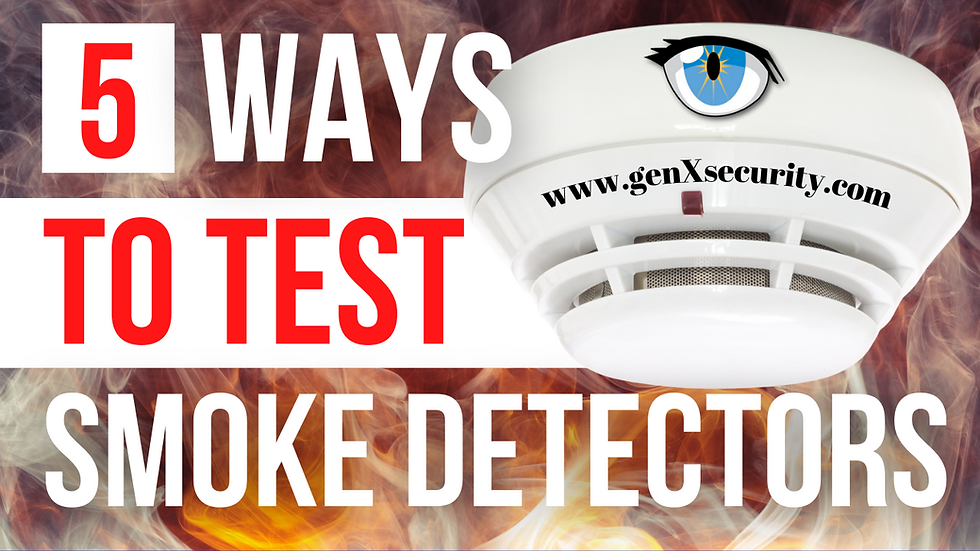The Five NFPA Allowed Methods of Testing Smoke Detectors
- GenX Security Solutions
- Apr 12, 2022
- 3 min read
Most know how to test a smoke detector at home, but when it comes to commercial fire alarms and smoke detectors did you know there are only 5 allowed methods of testing by the National Fire Alarm and Signaling Code (NFPA 72)? Yes, fire alarms and smoke detectors for commercial use are a whole different ball game! In this blog we'll briefly go over what you need to know about your commercial smoke detectors and the five allowed methods of testing them.

The NFPA outlines the five approved testing methods in Chapter 14 entitled Inspection, Testing and Maintenance, specifically Table 14.4.3.2, and they are as follows:
Calibrated test method
Manufacturer's calibrated sensitivity test instrument
Listed control equipment arranged for the purpose of testing
Smoke detector control unit arrangement whereby the detector causes a signal at the control unit when its sensitivity is outside its listed sensitivity range
Other calibrated sensitivity test method approved by the authority having jurisdiction
Let's delve in a little deeper...
Calibrated test method: For the calibrated test method, the detector is activated by inserting a magnet to put it into an internal test mode. The person testing the detector will then watch for a number of LED flashes on the detector which indicates if the detector is working properly, either within range or outside of listed range. The calibrated test method is most often used on older detectors. There is an alternative to using a magnet, however, and that is using a certain type of test instrument a controlled amount of smoke is injected into the detector. Unfortunately, the smoke method can be time consuming and has to be done just right to ensure an accurate result.
Manufacturer's calibrated sensitivity test instrument: Depending on the model of your smoke detector, there might be a special testing instrument. These instruments may involve an optical reader or utilize the test lack that is already part of the smoke detector. You'll find that newer smoke detectors tend to have manufacturer's calibrated sensitivity test instruments.
Listed control equipment arranged for the purpose of testing: The control unit is simply placed in a test or maintenance mode and a fire alarm technician can then run the sensitivity test from the addressable and addressable/analog FACP. For this method, one detector can be tested at a single time, or all detectors tested that are connected to the overall system. In addition, this type of test an be done remotely as long as the system's functionality is not compromised.
Smoke detector control unit arrangement: This type of testing is available within the unit itself whereby if a smoke detector move outside of the range at any time, a trouble signal will be generated.
Other calibrated sensitivity test methods approved by the authority having jurisdiction: As long as it is approved by the authority having jurisdiction over the smoke detector, other calibration methods and tools are allowed as long as they are able to successfully determine if a detector is in or out of range.
The next question you have might be, "what happens if a smoke detector is out of range?" The NFPA 72 code requires that the smoke detector is either cleaned and recalibrated, or replaced. And, sometimes it is just easier to replace the detector rather than go through the labor of cleaning it.
Having your smoke detectors tested and calibrated is very important to keep your fire alarm system operating as it was designed, as well as reducing and even eliminating the burden of false alarms!
Are you commercial smoke detectors in need of testing or replacement? Contact us. We can help!
Phone: 866-598-4369
Web: www.genXsecurity.com
Email: spencer@genxsecurity.com








![2020 Roaring Twenties Winner Badge[44136].jpg](https://static.wixstatic.com/media/c44162_312513fcb3514e3ca71a2a18b458369a~mv2.jpg/v1/fill/w_129,h_52,al_c,q_80,usm_0.66_1.00_0.01,enc_avif,quality_auto/2020%20Roaring%20Twenties%20Winner%20Badge%5B44136%5D.jpg)





























Comments